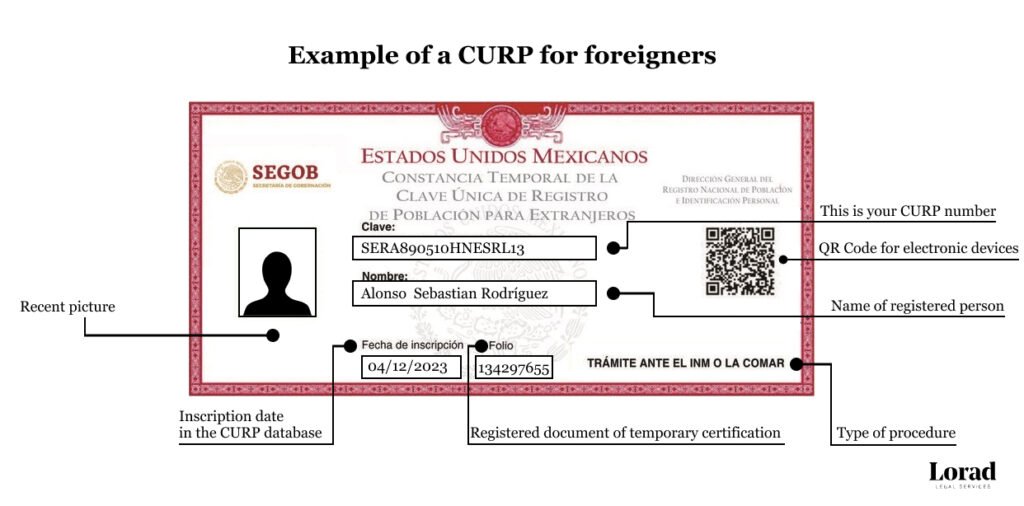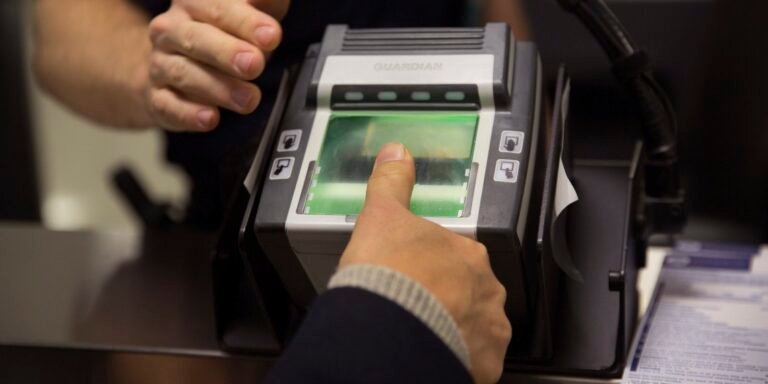If you’re an expat navigating the Mexican administrative system, you may have come across the term CURP.
But what exactly is a CURP, and why is it important for foreigners? You would not believe the number of emails we receive with the subject “Can an American get a CURP”? The answer is yes, and with the right immigration lawyer, you can get a CURP faster than you think!
In this blog post, we’ll demystify the meaning of the CURP and provide you with valuable information on how to get your very own CURP number and why it is important to have one if you are planning on living in Mexico.
Looking for our CURP test? Find out if you are eligible for a CURP! Hit the button and find out if you need a CURP and how to get one.
What is a CURP in Mexico?
The CURP (Clave Única de Registro de Población) is a unique identification number assigned to every resident in Mexico, including foreigners. It is made up of 18-character alphanumeric code that contains specific information about an individual. This code is generated based on personal data such as name, date of birth, and nationality. It provides a standardised and official identification system for residents in Mexico. If translated into English, the meaning of the CURP would stand for the Unique Population Registration Code
Brief history of the unique population registry code in Mexico
It was implemented in 1996 with the purpose of serving as a key identifier for various administrative processes and interactions with government entities. The first CURP ever was issued to the then president of Mexico, Ernesto Zedillo Ponce de León, as part of the initial implementation of the system to test its functionality! Having a CURP is essential for foreigners living in Mexico, as it facilitates access to services and ensures compliance with legal requirements.
Mexico CURP number example
Below you will find what is a CURP, and learn how to rea this document that is so important to Mexico.

Why do I need a CURP for in Mexico?
Having a CURP is of utmost importance for foreigners living in Mexico. It serves as a foundational document that grants access to a wide range of services and benefits, including healthcare, education, employment, and legal protections. Without a CURP, navigating the Mexican administrative system can be challenging and may result in delays or complications.
Moreover, it is important to note that some legal transactions, such as buying property or applying for a driver’s license, may require a CURP. It is considered an essential identification document that provides proof of your legal presence in Mexico.

Getting a CURP does not need to be a difficult process.
Contact our skilled lawyers and take a step forward towards living in Mexico.
What is a Mexican CURP Number?
Now that you know what a CURP looks like, let’s delve into understanding the intricacies of this 18-character alphanumeric code. The “Clave,” as mentioned above, is a unique identifier, and we’ll break it down for you to grasp its significance and the importance of having a CURP in Mexico.
Let’s imagine that this is our Mexican CURP number: QTIK330917MNTVWE28. Breaking it down to understand it better, we will divide the “Clave” like this: QTIK – 330917 – M – NT – VWE – 28
The meaning of CURP numbers
- First Four Letters: Derived from the person’s legal name, representing:
- First letter of the paternal surname
- First internal vowel of the paternal surname
- First letter of the maternal surname
- First letter of the given name
- Six Numbers: Indicating the person’s date of birth in YYMMDD format.
- Gender Indicator: A single letter specifying the person’s gender – “H” for male (hombre) and “M” for female (mujer).
- Two State Abbreviations: Representing the state of birth using the two-letter state abbreviation; for births outside Mexico, “NE” signifies Nacido en el Extranjero (born abroad).
- Next Three Letters: Derived from the person’s legal name, including:
- First internal consonant of the paternal surname
- First internal consonant of the maternal surname
- First internal consonant of the given name
- Duplicate Avoidance Character: A single character ensuring uniqueness among individuals with similar names, places, and dates of birth. It’s a number (0-9) for those born before 2000 and a letter (A-Z) for those born since 2000.
- Checksum: A single character used for validation and error-checking purposes.
Now that you know what the ‘clave’ in the CURP is, we could even create one ourselves! A CURP example could be “JYPP800503MTLVCO40” or “RYIO890925MTLZMR51“. You can now even understand more or less what each letter or number means!
Do I need a biometric CURP in 2025?
As of 2025, Mexico is introducing the Biometric CURP, an upgraded version of the existing CURP system that incorporates biometric data such as fingerprints, facial recognition, and iris scans. This new system aims to improve security, prevent identity fraud, and streamline administrative processes for both Mexican citizens and foreign residents.
With the Biometric CURP, foreigners living in Mexico can expect a more efficient process when accessing healthcare, financial services, legal procedures, and employment. The implementation of biometric technology will also provide greater accuracy in identity verification, reducing the risk of duplicate or fraudulent CURP registrations. If you’re planning to live or work in Mexico, getting your Biometric CURP will be essential for a better integration into the country’s administrative system.
What does biometric mean?
Biometric technology refers to the use of unique physical or behavioral characteristics to identify and verify individuals. These characteristics include fingerprints, facial recognition, iris scans, voice patterns, and even hand geometry. Unlike traditional identification methods that rely on documents or passwords, biometrics provide a more secure and reliable way to confirm a person’s identity because they are nearly impossible to duplicate or forge.
Biometrics are widely used in security, banking, healthcare, and government services to enhance authentication and prevent identity fraud. Many countries have implemented biometric identification systems for passports, national ID cards, and residency permits to improve efficiency and reduce fraudulent activity. With the introduction of the Biometric CURP in Mexico, this technology is now being integrated into the country’s population registry system to strengthen identity verification for both citizens and foreign residents.

Difference between a CURP number and a RFC
While both the CURP and the RFC (Registro Federal de Contribuyentes) are crucial identification tools in Mexico, they serve different functions and contain slightly varied information. The RFC is primarily used for tax purposes and is assigned by the Tax Administration Service (SAT).
Like the CURP, the RFC is an alphanumeric code, but it’s typically composed of 13 characters for individuals and 12 for moral entities. It includes the individual’s or entity’s name initials, date of birth or establishment, and a homoclave – a set of three characters used to avoid duplications.
Unlike the CURP, which includes gender and state of birth, the RFC doesn’t contain these specifics, demonstrating its focus on fiscal identification rather than comprehensive demographic data.
Some American clients have mentioned that the CURP is like a SSN. And in some ways, this could be true, since both serve as unique identification numbers for individuals and are used in various administrative and official processes.
Here you can see the difference between CURP and RFC codes:
CURP: HYVS470421MOCQOF75
RFC: GKHK780805AX5
As you can see, the CURP code is longer and ends with two numbers.
The CURP is used for civil and administrative purposes, such as accessing social services, healthcare, and education. It is also required for certain transactions and interactions with government agencies.
Similarly, the SSN in the United States is a unique identification number issued by the Social Security Administration. It is primarily used for tracking individuals’ earnings and benefits. The SSN is widely used in the U.S. for various purposes, including employment, financial transactions, and government benefits.
While there are similarities, it’s important to note that the CURP and SSN have distinct purposes and are managed by different authorities in their respective countries.
How to Get a CURP for Mexico
The process of obtaining a CURP depends on whether you are in Mexico or outside of Mexico.
If you are in Mexico:
- Visit the nearest Registro Civil office or CURP registration center.
- Provide the necessary documentation, including proof of identity and immigration status.
- Fill out the CURP application form.
- Submit your application and wait for your CURP to be generated.
If you are outside of Mexico:
- Contact the nearest Mexican consulate or embassy.
- Inquire about the process for obtaining a CURP as a foreign resident.
- Provide the required documentation, which may include proof of identity, residency status, and any additional documents requested by the consulate or embassy.
- Follow the instructions provided by the consulate or embassy to complete the application process.
Do you need a CURP? Take this test and find out!
After reading this blog post, you must know way more about what a CURP is and the importance of a CURP in Mexico. But just to be sure, why don’t you take our test and find out if you need a CURP for your adventure in Mexico.
Frequently asked CURP questions
Do I need a CURP if I’m just living in Mexico temporarily?
Yes, most likely. The CURP is needed for anyone residing in Mexico to access services like opening a bank account, signing a long-term lease, or enrolling in healthcare. It’s not just for permanent residents.
Is the CURP my new tax number (RFC)?
No, they are two separate numbers for different purposes. You need your CURP for general identification with the government, but you will need a separate RFC specifically for anything related to taxes, like getting a job or starting a business.
Can I use my CURP card as an ID to get into a bar or board a plane?
No. Your CURP is for administrative purposes. For situations that require a photo ID, like a security check or verifying your age, you should always use your passport or your Mexican residency card.
Once I get my CURP, is it mine for life?
Yes! Your CURP number is unique and permanent to you. Even if your residency card expires and you renew it, your CURP number itself will not change.
Beyond just getting the number, how does a CURP integrate with my overall immigration status?
Your CURP is much more than just a 18-digit code; it’s the key that connects your immigration status to daily life in Mexico. Think of it this way: your residency card (from SEMIGRACIÓN or INM) grants you the legal right to be in the country, while your CURP is the tool that activates that right for almost everything else.
Conclusion about CURP in Mexico
Obtaining a CURP is crucial for foreigners living in Mexico. It not only facilitates access to essential services but also ensures compliance with legal requirements. If you are a foreign resident in Mexico and do not have a CURP, we strongly recommend reaching out to our Mexican bilingual lawyers to guide you through the process and assist you in obtaining your CURP as soon as possible.
Remember, having a CURP is not only a legal obligation but also a gateway to fully enjoying your life and experiences in Mexico. Don’t hesitate to take this important step and secure your identification as a resident in Mexico.
Contact our bilingual legal attorneys today to embark on your CURP application journey. Your peace of mind and seamless integration into Mexican society await!

Pingback: Codice unico del registro della popolazione - Wikipedia - zonasapiens
Pingback: What is a RFC in Mexico and how do I get one? - Lorad Law